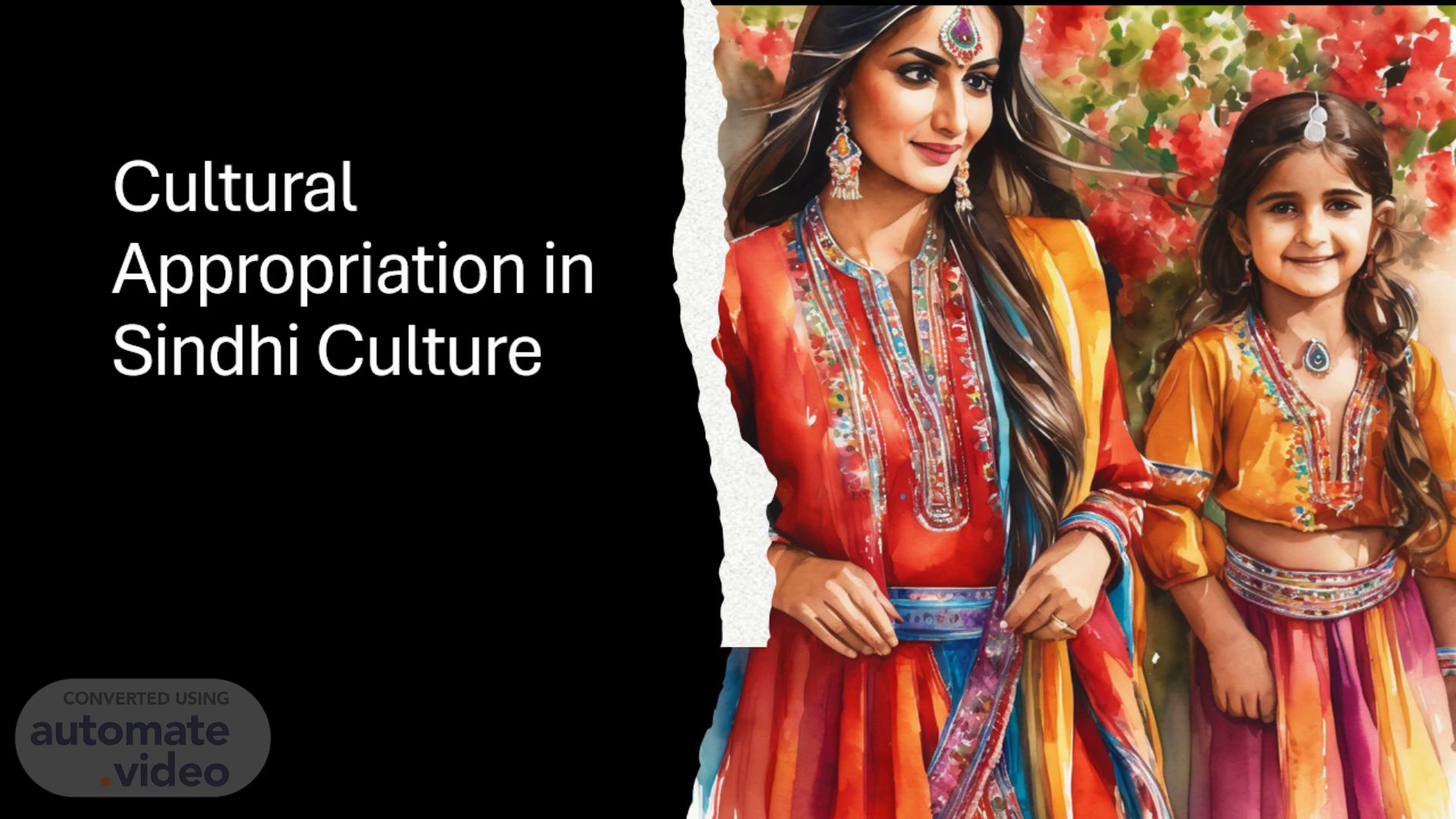
Cultural Appropriation in Sindhi Culture
Scene 1 (0s)
Cultural Appropriation in Sindhi Culture. [image] A person and a child in colorful dresses Description automatically generated.
Scene 2 (9s)
Definition of Cultural Appropriation. The term "cultural appropriation" describes the adoption, borrowing, or imitation of aspects of another culture by people or organizations that might not completely comprehend or honor the context and cultural significance of those aspects [^1^]. It entails appropriate recognition and comprehension of the historical, social, and cultural significance of appropriating elements of a marginalized culture for one's benefit or without acknowledging them[^2^]. In addition to depriving cultural practices of their original significance and contributing to the erasure and commercialization of marginalized cultures, cultural appropriation can reinforce stereotypes[^3^]. Respect, tact, and a desire to learn and have meaningful conversations are essential when approaching cultural exchange[^4^]..
Scene 3 (38s)
History and Importance of a Cultural Element. Cultural Element: Ajrak In Sindhi culture, ajrak is a traditional textile print that holds great cultural value. It is a distinct kind of block printing distinguished by vivid colors and complex geometric designs. The word "ajrak" comes from the Arabic word "azrak," which means "blue." In Sindhi tradition, blue is revered and thought to ward off evil spirits. Historical Background Ajrak's rich cultural legacy is profoundly ingrained in the centuries-old history of the Sindhi people. It is one of the world's oldest textile traditions, thought to have its roots in the Indus Valley Civilization. Generations of artists have carried on the skill of ajrak block printing, producing these elaborate designs using natural dyes and age-old methods. Importance and Meaning In Sindhi culture, ajrak is very significant since it represents the identity, culture, and values of the Sindhi people. It is a depiction of their history, customs, and way of life rather than merely a piece of cloth. The richness and vitality of Sindhi culture are reflected in the vivid colours and elaborate designs of ajrak..
Scene 4 (1m 26s)
Appropriation of the Cultural Element. Appropriators Non-Sindhi individuals and fashion designers have appropriated the cultural element of traditional Sindhi clothing and embroidery. Why is it Considered Appropriation? Because the cultural components are removed from their native context and used for trendiness or personal advantage without consent or knowledge of their cultural value, this is deemed appropriation. Usage The appropriators frequently exploit these cultural aspects without acknowledging or respecting their cultural value in fashion displays, runway events, and regular clothing.. Upset and Offended This appropriation, which diminishes the value and relevance of their cultural history, has angered and alienated many members of the original Sindhi culture. Social media posts and statements made in public by activists and leaders of the Sindhi community serve as evidence of this..
Scene 5 (2m 4s)
Appreciation of the Cultural Element. I think it's important to approach Sindhi culture thoughtfully and respectfully since I respect and value it. Learning about the background, customs, and importance of the Sindhi cultural aspects we are interested in is one of the most crucial phases. This understanding fosters a more genuine appreciation of these features by assisting us in appreciating their context and significance. Providing support to Sindhi artists and artisans who produce traditional crafts, apparel, and artwork is another way to express gratitude. By buying their goods, we support the preservation of Sindhi cultural legacy in addition to recognizing their talent. Engaging in cultural events, festivals, and celebrations of the Sindhi community is an excellent means of fully experiencing the richness of the culture. By giving us the opportunity to engage directly with the customs, music, dancing, and food, it deepens our understanding and admiration of them. Working with Sindhi communities and individuals is essential if we want to include aspects of Sindhi culture in our work or projects. Working together and honouring their opinions will help us make sure that our efforts are sincere and polite, free from any appropriation or deception. In the end, having a true appreciation for Sindhi culture requires respect, comprehension, and a readiness to learn about and participate in the community meaningfully..
Scene 6 (3m 1s)
Sources. Adapted from National Museum of the American Indian. (n.d.). Cultural appropriation. Retrieved from Brown, K. (2017). Cultural Appropriation: The Act of Stealing and Destroying. The Huffington Post. Retrieved from Sueyoshi, A. (2020). Cultural Appropriation and the Commodification of Culture. The Society Pages. Retrieved from The Canadian Commission for UNESCO. (2018). Guidelines for Respecting Cultural Appropriation. Retrieved from.